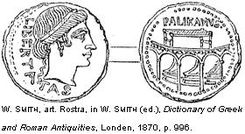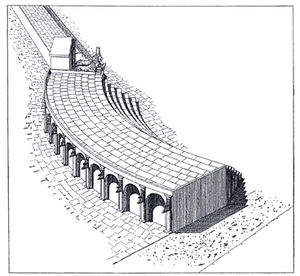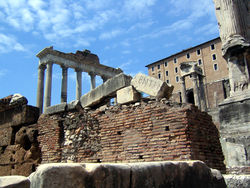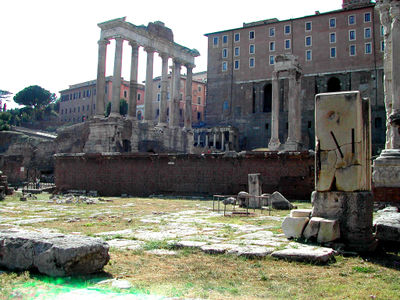Rostra
 The Rostra of the early Republican era, as depicted on a Roman coin |
|
| Lapis Niger | |
|---|---|
| Comitium | |
| Julius Caesar | |
| Roman Government | Political institutions |
| Social classes | Patrician, Senatorial class, Equestrian class, Plebian, Freedman |
| The Rostra was a specific platform for oration, located in honored space filled with monuments to past glories and fallen heroes, known as the Comitium | |
 |
|
| These articles cover the Ancient Roman Comitium of the Republican era | |
|---|---|
| Structures- | Rostra, Curia Hostilia, Curia Julia, Lapis Niger, Temple of Felicitas |
| Politicians- | Cicero, Gaius Gracchus, Julius Caesar |
| Assemblies- | Roman Senate, comitia curiata |
The Rostra (Italian: Rostri) was a large platform built in the city of Rome that stood during the republican and imperial periods.[1] Speakers would stand on the rostra and face the north side of the comitium towards the senate house and deliver orations to those assembled in between. It is often referred to as a suggestus or tribunal,[2] the first form of which dates back to the Roman Kingdom, the Volcanal.[3][4]
It derives its name from the six rostra (plural of rostrum, a warship's ram) which were captured during the victory at Antium in 338 BC and mounted to its side.[5] Originally, the term meant a single structure located within the Comitium space near the Forum and usually associated with the Senate curia. It began to be referred to as the Rostra Vetera ("Elder Rostra") in the imperial age to distinguish it from other later platforms designed for similar purposes which took the name "Rostra" along with its builder's name or the person it honored.
Magistrates, politicians, advocates and other orators spoke to the assembled people of Rome from this highly honored, and elevated spot.[6] Consecrated by the Augurs as a templum, the original Rostra was built as early as the 6th century B.C. This Rostra was replaced and enlarged a number of times but remained in the same site for centuries.
Julius Caesar rearranged the Comitium and Forum spaces and repositioned the Senate Curia at the end of the republican period. He moved the Rostra out of the Comitium when the Curia Cornelia was dismantled. This took away the commanding position the curia had held within the whole of the forum, having advanced extremely close to the Rostra during its last restoration. Augustus, his nephew and first Roman emperor, finished what Caesar had begun, as well as expand on it. This became known as Rostra Augusti. What remains in the excavated forum today, next to the Arch of Septimus Severus has endured several restorations and alterations throughout its historical use. while a few different honorary names are attributed to those restorations, scholars, archeologist and the government of Italy recognise this platform as the "Rostra Vetera" encased inside the "Rostra Augusti".
The term "Rostrum", referring to a podium for a speaker is directly derived from the use of the term "Rostra". One stands in front of a Rostrum and one stands upon the Rostra. While, eventually, there were many rostra within the city of Rome and its republic and empire, then, as now, "Rostra" alone refers to a specific structure.
Contents |
History
Before the Forum Romanum, the Comitium was the first designated spot for all political and judicial activity and the earliest place of public assembly in the city. The people of Rome gathered here to listen to orators beginning with the "Kings" of Rome to Cicero, delivering one of his epic orations. A succession of earlier shrines and altars is mentioned in early Roman writings as the first suggestum. It consisted of a shrine to the god Volcan, that had two separate altars built at different periods. This early Etruscan mundus alter originaly sat in front of a temple that would later be converted into the Curia Hostilia.
During the late Republic the rostra was used as a place to display the heads of defeated political enemies. Gaius Marius and consul Lucius Cornelius Cinna captured Rome in 87 B.C. and placed the head of the defeated consul, Gnaeus Octavius, on the Rostra.[7] The practice was continued on by Sulla[8] and Mark Antony, who ordered that Cicero's hands and head be displayed on Caesar's Rostra after the orator's execution as part of the Proscription of 43 B.C..[8]
Caesar spoke from the Rostra in 67 B.C. in a successful effort to pass, over the opposition of the Senate, a bill proposed by the tribune Aulus Gabinius (the Lex Gabinia) creating an extraordinary command for Pompey to eliminate piracy in the Mediterranean.[9] Brutus and Cassius spoke from the Rostra to an unenthusiastic crowd in the Forum after the assassination of Caesar in 44 B.C..[10] Millar comments that during the late Republic, when violence became a regular feature of public meetings, physical control and occupation of the Rostra became a crucial political objective.[11]
Tribal assemblies and tribunals
Until about 145 B.C., the Comitium was the site for tribal assemblies (comitia tributa) at which important decisions were taken, magistrates were elected and criminal prosecutions were presented and resolved by tribal voting. Before an assembly, the convening magistrate, acting as augur, had to take the auspices in the inaugurated area (templum) on the Rostra from which he was to conduct the proceedings. If the omens were favorable and no other magistrate announced unfavorable omens, the magistrate summoned other magistrates and senators and directed a herald to summon the people. Heralds did so from the Rostra and from the City walls. During an assembly, magistrates, senators and private citizens spoke on pending legislation or for or against candidates for office. Before bills were presented for voting, a herald read them to the crowd from the Rostra. As the culmination of the process, the tribes were each called up to the templum on the Rostra to deliver their votes. After about 145 B.C., the voting population of Rome grew too large for the Comitium, and tribal assemblies were then held at the opposite end of the Forum around the Temple of Castor, the steps of which served as an informal Rostra.[12][13][14]
The Rostra was also used for meetings of courts.[15] In Republican Rome, criminal prosecutions took place in the Forum either before a tribal assembly with a magistrate prosecuting (a procedure specified in the Twelve Tables and the normal mode of prosecution in the middle Republic) or in a jury-court (quaestio de repetundis) established by statute and presided over by a magistrate with a jury (after 70 B.C.) of about 50-75 jurors.[16] For trials held in the Comitium, the Rostra served as the tribunal upon which the magistrate sat in his curule chair with a small number of attendants. "This was enough in itself to establish a court, though it was supplemented by benches (subsellia) for the jurors, the parties to the case, and their supporters." The circle of onlookers (corona) either stood or sat on nearby steps.[17][18]
Vulcanal

Underneath the Lapis Niger is the Vulcanal, an altar to the god Vulcan, two pedestals, an honorary column base and an ancient stele, which is the oldest part of the shrine. This spot is defined as the first Suggestum. This shrine and altar faced out to the forum.[19]
The original Rostra was built during the middle years of the Roman Republic in approximately 500 BC.[8] It subsequently became known as the "Rostra" after the end of the Latin War in 338 B.C. when it was adorned with the prows (rostra) of ships captured from Antium as war trophies.[20]
The Rostra was located on the south side of the Comitium opposite the Curia Hostilia (the original Senate house), overlooking both the Comitium and the Roman Forum. In addition to the prows of captured ships, the Rostra bore a sundial[21] and, at various times, statues of such important political figures as Camillus, Sulla and Pompey.[11][22] Private citizens also erected a number of honorary columns and monuments on the Rostra and through out the forum. At one point, the Senate threatened to have them removed if the donors did not do so themselves.[23]
Rostra Vetera
In form, the original Rostra may have been a simple raised platform made of wood, similar to the roman tribunal.[24] The Rostra had a curved form, possibly along the outer south rim of an Amphitheatre. The structure was described by Christian Charles Josias Bunsen, based on his examination of two Roman coins depicting the Rostra, as "a circular building, raised on arches, with a stand or platform on the top bordered by a parapet; the access to it being by two flights of steps, one on each side. It fronted towards the Comitium, and the rostrum were affixed to the back of it, on column supports. Its form has been in all the main points preserved in the ambones, or circular pulpits, of the most ancient churches, which also had two flights of steps leading up to them, one on the east side, by which the preacher ascended, and another on the west side, for his descent. Specimens of these old churches are still to be seen at Rome in the churches of St. Clement and S. Lorenzo fuori le mura.[25]
Debate and confusion of architectural elements

There have been many ideas and theories put forth over the last 100 years as to the architectural elements of the structure. Very few images survive depicting the pre-imperial period Rostra.
Excavations have added to the confusion by showing many layers of the comitium space and at least three separate stages of the Rostra. Disasters, such as fire and invasion destroyed the area and restorations never stayed faithful to the previous shape or form. Each consecutive restoration to the Rostra Vetera after its initial move into the forum gave the monument a new name only adding to the confusion.
In his book, "Mass Oratory and Political Power in the Late Roman Republic", author Robert Morstein-Marx has theorized that there may never have been a reorganization of the comitium by Sulla. His claim is that there simply is no evidence of such. Marx uses the work of archaeologist Einar Gjerstad's diagrams to suggest that the Rostra Vetera itself was the only part of the comitium that was circular. However, archaeological evidence in other Roman Republican Cities from that period , such as the city of Cosa, show a circular amphitheatre directly in front of the city curia in smaller scale with a "rostra" on their steps. While this is not direct evidence, is does suggest that the hemicycle remains in the comitium of Rome are what is left of a similar structure.
There are several depictions of a large Rostra during imperial times on a number of monuments in Rome. They had been associated with the Augustin rostra at one time, leading early researchers to conclude that the rostra represented the same structure as the early republican platform. But, recent understanding of the Rostra Diocletioni is now credited for must of these depictions. Its size was comparable and it also was built in the Forum Romanum.
While the remains in the forum are today referred to as the Rostra Augusti as identified through historic writings, it is still believed to be, at its core, the original Rostra Vetera. Named so during Caesar’s time only to distinguish it with reverence and honor. With the move, the structure becoms referred to as the Rostra Caesarian. When Augustus expands it, it becomes the Rostra Augusti. Since the time of Augustus Caesar, the Rostra was restored and expanded further with additional names linked to this same building.
Honorary names
Rostra Augusti

As part of his reconstruction of the Roman Forum in 44 B.C., Julius Caesar is believed to have moved the republican Rostra Vetera.[26] This Rostra, referred to as the "Caesarian Rostra" by archaeologists, reused and incorporated nearly all of the original Rostra. Located on the southwest side of the new Julian Forum (Forum Iulium), the new Rostra was no longer subordinated to the new Senate House of the time (Curia Cornelia); Caesar had it placed on the central axis of the Forum Iulium opposite the Temple of Caesar. Left uncompleted at Caesar's death, Augustus finished and extended the new Rostra into a rectangle at the front. The new Rostra was called the "Rostra Vetera" to distinguish it from another Rostra, built by Augustus in 29 B.C. at the opposite end of the Forum. This Rostra was part of the Temple to the Divine Caesar and was decorated with the rams from the Battle of actium. The late John E. Stambaugh, professor of classics at Williams College, described the new arrangement as "a reflection of contemporary taste and the relentless Augustan desire for order."[22][27]
Rostra Vandalica

As the Rostra Augusti incorporates the old Rostra vetera, so does the Rostra Vandalica to the Augustin monument. This portion is either a simple modification to lengthen the front of the old rostra or to give a space on it specifically for the common people of Rome. This add-on of simple brick, appears to be hastily and poorly constructed. It only constitutes a tiny section of the Rostra as a whole, but may well have given name to the entire structure at that time and not just that specific section as was common after restorations. The section also had the beaks of ships mounted on its front, but to what battle they would be attributed to is unclear as the Romans had no naval enemies at that time and may simply have been replicas fabricated to keep the exterior architectural elements the same. Even its marble veneer was of the same type as the rest of the structure, suggesting that it was not as noticeable an add on in ancient times.
A marble plaque with inscriptions has been located and replaced on top of the spot. Its odd placement and lower stance as well as the inscription itself have been the subject of much discussion and debate.
Rostra Ad Palmam/Domitian/Flavian Rostra
These names appear to simply be the Rostra Augusti renamed after subsequent restorations by those specific patrons. All writings refer to these in the same topographic location.
Site today

The structure visible today is the result of an early twentieth-century restoration. Only the large brown tufa blocks are original and are believed to have been moved by Caesar from their original Comitium location. All of the stone masonry to the left, when facing the rostra, (which constitutes almost 90% of the visible structure) is a modern reconstruction using contemporary materials. Up until the early to mid 1800s the site was home to a group of ramshackle buildings, torn down after the Italian government purchased the land to excavate the forum monuments and structures. The brick add on to the structures right end was built at the time of Septimus Severus. Archaeologists continue to debate which Rostra the ruins represent, but they are commonly believed to be that of Julius Caesar and Augustus.
In contemporary news
In November 2008 heavy rain damaged the concrete covering that has been protecting the Vulcanal and its monuments located in the Imperial comitium space since the 1950s. This includes the stele accorded the name of "The Black Rock" or Lapis Niger. The marble and cement covering is a mix of the original black marble, said to have been used to cover the site by Sulla, and modern cement used to create the covering and keeping the marble in place.
Professor Angelo Bottini, Superintendent of Archeology in Rome, stated that an awning or tent covering is in place to protect the ancient relics until the covering is repaired, giving tourists of this millennium a look at the original suggestum for the first time in 50 years.[28]
Other known Rostra
Rostra Iulii
In 29 B.C. Augustus ordered the construction of another Rostra in front of the Temple of Caesar, at the opposite end of the Forum Iulium from Caesar's Rostra. This was used as a tribunal and was adorned with the prows of galleys captured at the Battle of Actium.[22][29]
Rostra Diocletiani
Located directly in front of the Temple of Caesar, this rostra was on the Roman forum on the opposite side from the Rostra Augusti. It is approximately as large as the Augustin rostra but has several access doorways underneath the top platform. It is this rostra that has come to confuse researchers and historians because it was not known to exist even after the initial excavations of the forum. Due to a misinterpretation of the age of the structure and lack of translated written accounts as well as the different names given this structure and others incorrectly, nearly the entire rostra was torn down and dismissed as a medieval building. Until its discovery in the Twentieth Century, many references and images of this structure were incorrectly attributed to Rostra Augusti and debate continues as to whether the form of the Augustin monument is correctly reconstructed. It is believed the Rostra Diocletiani is depicted on the Arch of Constantine and not the Augustin structure.
See also
- Esther Boise Van Deman
- Einar Gjerstad
References
- Notes
- ↑ Nichols, Francis Morgan (1877). The Roman Forum. London. Longmans and Co.. pp. 196. ISBN 9781437320961.
- ↑ Richardson, Lawrence (1992). A new topographical dictionary of ancient Rome. The Johns Hopkins University Press. pp. 400. ISBN 978-0801843006.
- ↑ Lanciani, Rodolfo Amedeo (1900). The ruins and excavations of ancient Rome. Bell Publishing Company (1979). pp. 278. ISBN 0517289458.
- ↑ O'Connor, Charles James (1904). The Graecostasis of the Roman forum and its vicinity. University of Wisconsin. pp. 183. ISBN 9781104391416.
- ↑ Murray, Michaēl, William Michael, Phōtios (1989). Octavian's campsite memorial for the Actian War. DIANE Publishing. pp. 109. ISBN 9780871697943.
- ↑ Smith, Wayte, Marindin, William, William, George (1891). A dictionary of Greek and Roman antiquities. John Murray, Albemarle Street London.. pp. 567. ISBN 0933029829.
- ↑ Caesar, Life of a Colossus By Adrian Goldsworthy. Google books. http://books.google.com/books?id=K8wBTzdZG5UC&printsec=frontcover&dq=Caesar:+Life+of+a+Colossus#PPA46,M1. Retrieved 2009-07-01.
- ↑ 8.0 8.1 8.2 Vasaly, Ann (January 25, 1996). Representations. University of California Press. pp. 73. ISBN 978-0520201781.
- ↑ Caesar, Life of a Colossus By Adrian Goldsworthy. Google Books. http://books.google.com/books?id=K8wBTzdZG5UC&printsec=frontcover&dq=Caesar:+Life+of+a+Colossus#PPA103,M1. Retrieved 2009-07-01.
- ↑ Goldsworthy, Adrian (2008). Caesar, Life of a Colossus. Yale University Press. pp. 509. ISBN 978-0300126891.
- ↑ 11.0 11.1 Millar, Fergus (2002). The Crowd in Rome in the Late Republic (Thomas Spencer Jerome Lectures). Google books. p. 41. ISBN 0472088785. http://books.google.com/books?id=YVBNzYQy5vYC&dq=The+Crowd+in+Late+Republican+Rome&printsec=frontcover&source=bn&hl=en&sa=X&oi=book_result&resnum=5&ct=result#PPA41,M1. Retrieved 2009-06-01.
- ↑ Lintott, Andrew William (1999). The Constitution of the Roman Republic. Oxford University Press. pp. 42–49. ISBN 0198150687.
- ↑ Powell, J. G. F.; Paterson, Jeremy (2006). Cicero the Advocate. Oxford University Press. ISBN 0199298297. http://books.google.com/books?id=Ohs779fwTnMC&pg=PP7&dq=Cicero+the+Advocate.+Oxford:+Oxford+University+Press#PPA68,M1. Retrieved 2009-07-01.
- ↑ Stambaugh, John E. (1988). The Ancient Roman City. John Hopkins University Press. p. 104. ISBN 0801836921. http://books.google.com/books?id=k0mZufizhH0C&printsec=frontcover&dq=The+Ancient+Roman+City.#PPA104,M1. Retrieved 2009-07-01.
- ↑ Lintott, Andrew William (1999). The Constitution of the Roman Republic. Oxford University Press. pp. 44–46. ISBN 0198150687.
- ↑ Powell and Paterson, J. G. F and Jeremy (2004). Cicero the Advocate. Oxford University Press. pp. 32, 62, 68. ISBN 0-19-815280-9..
- ↑ Powell and Paterson, J. G. F and Jeremy (2004). Cicero the Advocate. Oxford University Press. pp. 63. ISBN 0-19-815280-9..
- ↑ Stambaugh, John E. (1988). The Ancient Roman City (Ancient Society and History). John Hopkins University Press. ISBN 0801836921. http://books.google.com/books?id=k0mZufizhH0C&printsec=frontcover&dq=The+Ancient+Roman+City#PPA105,M1. Retrieved 2009-07-01.
- ↑ Mass Oratory and Political Power in the Late Roman Republic By Robert Morstein-Marx. Google Books. http://books.google.com/books?id=ZwkJh1cZb1YC&pg=PA45&dq=Roman+Rostra+Comitium&ei=gDFkSeDADI_ekwSd3eGYDw#PPA45,M1. Retrieved 2009-01-06.
- ↑ "Rostra, William Smith, D.C.L., LL.D.:A Dictionary of Greek and Roman Antiquities, John Murray, London, 1875.". University of Chicago. http://penelope.uchicago.edu/Thayer/E/Roman/Texts/secondary/SMIGRA*/Rostra.html. Retrieved 2009-03-08.
- ↑ Hannah, Robert (January 8, 2009). Time in Antiquity. Routledge; 1 edition. pp. 134. ISBN 978-0415331562.
- ↑ 22.0 22.1 22.2 Hornblower and Spawforth, Simon and Antony (1949). The Oxford Classical Dictionary. Oxford University Press. pp. 1336. ISBN 0-19-866172-X..
- ↑ The Roman Forum By Francis Morgan Nichols. google books. http://books.google.com/books?id=dYM2AAAAMAAJ&pg=PA86&dq=Rostra+and+forum+statues&ei=GCRoScOHEZTElQSHh61o#PPA85,M1. Retrieved 2009-08-01.
- ↑ Forbes, S. Russell (January 1, 1892). Rambles in Rome: An Archaeological and Historical Guide to the Museums, Gal. Thomas Nelson and Sons. pp. 43. ISBN NA.
- ↑ Quoted in Arnold, footnote 54, 274.
- ↑ Sumi, Geoffrey (September 28, 2005). Ceremony and power: performing politics in Rome between Republic and Empire. University of Michigan Press; illustrated edition edition. pp. 78-80. ISBN 978-0472115174.
- ↑ Stambaugh, John E. (1988). The Ancient Roman City. John Hopkins University Press. pp. 59. ISBN 0-8018-3692-1..
- ↑ "SIte of Romulus's murder to be tourist draw". Times Online. http://www.timesonline.co.uk/tol/news/world/europe/article5216946.ece. Retrieved 2009-07-01.
- ↑ Stambaugh, John E. (1988). The Ancient Roman City. John Hopkins University Press. pp. 118–119. ISBN 0-8018-3692-1..
- Bibliography
- Goldsworthy, Adrian (2006). Caesar. New Haven: Yale University Press. ISBN 0300120486.
- Hannah, Robert (2009). Time in Antiquity. City: Routledge. ISBN 978-0415331562.
- Hornblower, Simon (1996). The Oxford Classical Dictionary. Oxford Oxfordshire: Oxford University Press. ISBN 019866172X.
- Lanciani, Rodolfo (1979). The Ruins and Excavations of Ancient Rome. New York: Bell Pub. Co. ISBN 0517289458.
- Lexikon, Herder (1994). The Chiron Dictionary of Greek and Roman Mythology. Wilmette: Chiron Publications. ISBN 0933029829.
- Lintott, Andrew (1999). The Constitution of the Roman Republic. Oxford: Clarendon Press. ISBN 0199261083.
- Millar, Fergus (1998). The Crowd in Rome in the Late Republic. Ann Arbor: University of Michigan Press. ISBN 0472108921.
- Morstein-Marx, Robert (2004). Mass Oratory and Political Power in the Late Roman Republic. Cambridge: Cambridge University Press. ISBN 0521823277.
- Nichols, Francis (2008). The Roman Forum: a Topographical Study. City: Kessinger Publishing, LLC. ISBN 9781437320961.
- O'connor, Charles (2009). The Graecostasis of the Roman Forum and Its Vicinity. City: Kessinger Publishing, LLC. ISBN 9781104391416.
- Paterson, Jeremy (2004). Cicero the Advocate. Oxford Oxfordshire: Oxford University Press. ISBN 0198152809.
- Richardson, Lawrence (1992). A New Topographical Dictionary of Ancient Rome. Baltimore: Johns Hopkins University Press. ISBN 9780801843006.
- Stambaugh, John (1988). The Ancient Roman City. Baltimore: Johns Hopkins University Press. ISBN 0801836921.
- Vasaly, Ann (1996). Representations. Berkeley: University of California Press. ISBN 9780520201781.
External links
- Plan showing location in the Forum Romanum
- Coin depicting the ships prows attached to the rostra, and photograph showing the length of the rostra
- Further on the history of the rostra in the Forum Romanum
- Graphic reconstruction of the view of the rostra with the ships prows
|
||||||||||||||||||||